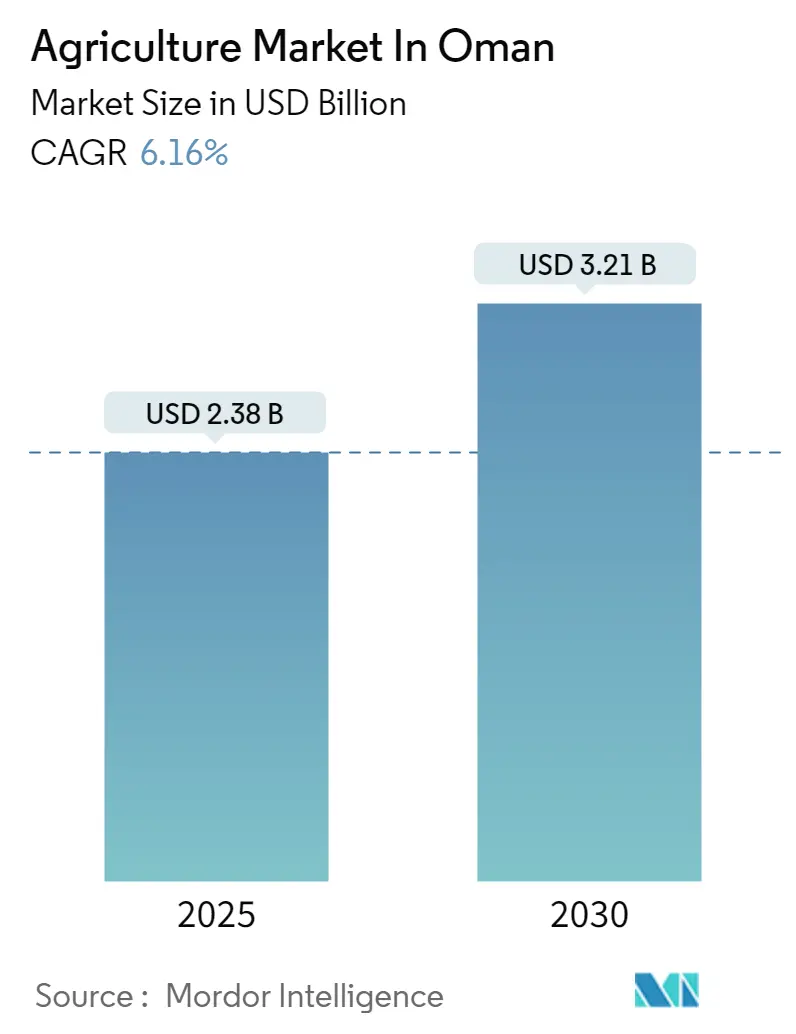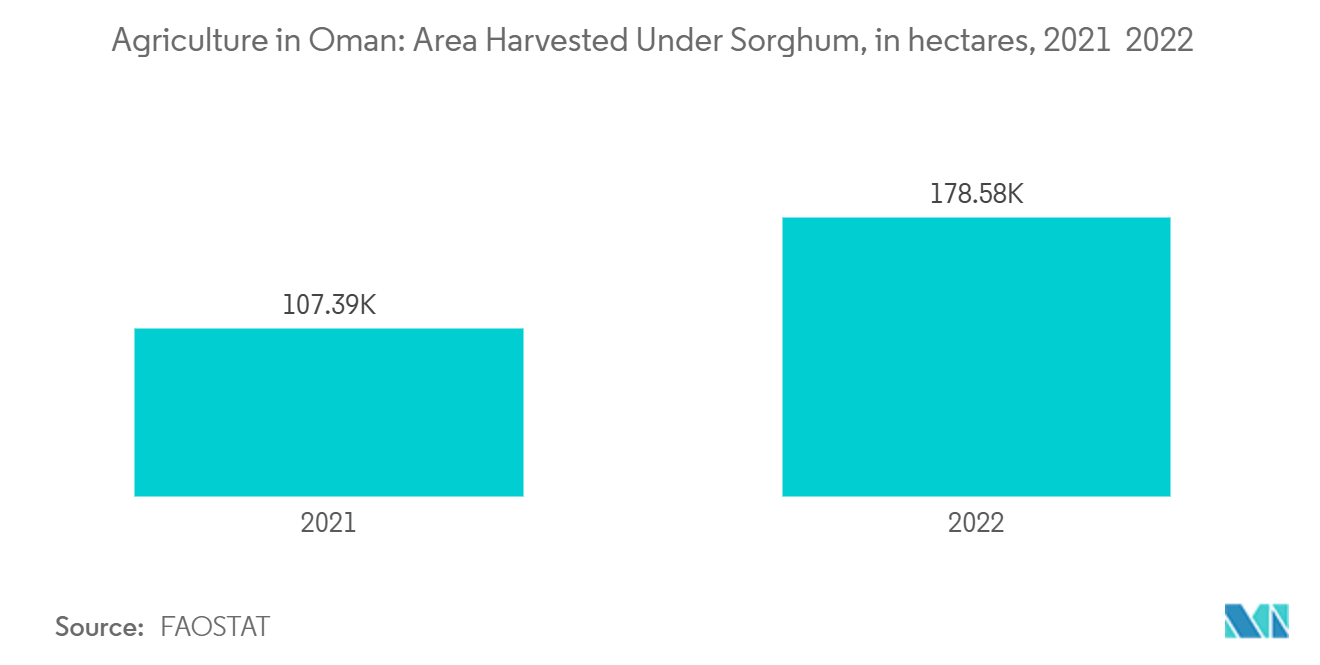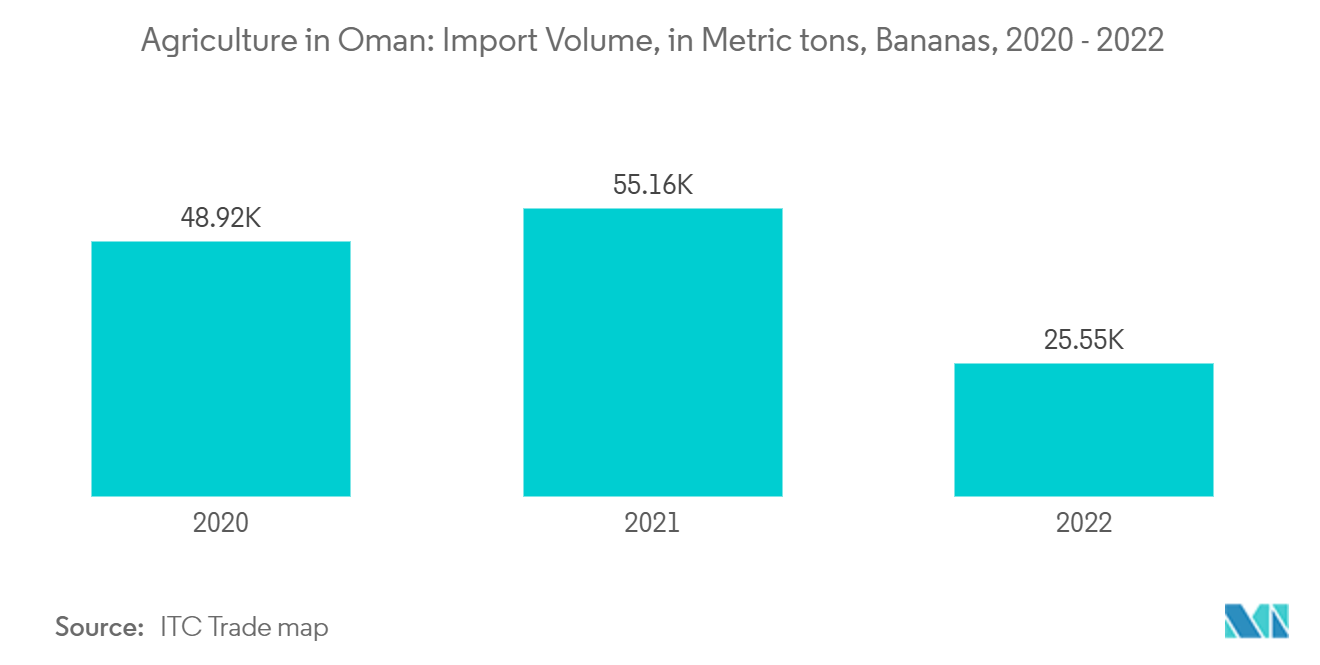Oman Agriculture Market Analysis
The Agriculture Market In Oman Market size is estimated at USD 2.38 billion in 2025, and is expected to reach USD 3.21 billion by 2030, at a CAGR of 6.16% during the forecast period (2025-2030).
- Agriculture has been integral to Oman's economy for centuries. In 2022, the agricultural and fisheries sectors contributed 1.8% to Oman's GDP, according to World Bank data. The fertile coastal plains in Batina and Salala, along with the cooler high plateau climate of Al Jabal al Akhdar, support the cultivation of various fruits such as apricots, grapes, peaches, and walnuts. Additionally, the adoption of advanced farming technologies and favorable government policies are driving the market growth.
- The government has established research and development centres across the country to promote agricultural mechanization and introduce new farming methods and crops, aiding the sector's growth. In 2023, the Ministry of Agriculture, Fisheries, and Water Resources launched the 'Oman Seed Bank to safeguard and enhance local crop diversity. This strategic repository conserves seeds, breeds new varieties suited to Oman's environment, and distributes them to farmers, significantly boosting agricultural yields. These initiatives are expected to drive agricultural growth in Oman during the forecast period.
- Oman relies on imports to meet its domestic demand for fruits, vegetables, and cereals. To reduce this dependency, the country aims for self-sufficiency in agricultural products. Sustainable development in the agriculture sector is expected to increase its contribution to GDP, enhance employment, and improve the trade balance. Therefore, the adoption of technological advancements in agriculture, coupled with rising government support, is driving market growth during the forecast period.
Oman Agriculture Market Trends
Growing Area under Cereal production
In recent years, Oman has seen a notable expansion in its cereal production area, driven by several pivotal factors reshaping the nation's agricultural landscape. Central to this growth is the Omani government's commitment to bolstering food security and achieving self-sufficiency. For example, the alignment of the tenth Five-Year Plan (2021-2025) with Oman Vision 2040 aims to elevate food production across diverse sources, achieving a remarkable 151% self-sufficiency rate in grains by 2024. Such ambitious self-sufficiency targets have not only propelled cereal and grain production but have also invigorated Oman's agricultural sector.
Wheat, barley, maize, and sorghum stand out as the primary cereals cultivated in Oman. Technological advancements in agriculture have been instrumental in this expansion. The integration of modern farming tools, advanced irrigation methods, and refined crop management strategies has empowered Omani farmers to enhance their cereal cultivation efficiency. Techniques like drip irrigation and other water-conserving methods have optimized water resource usage, leading to expanded arable land and heightened cereal yields. FAO statistics highlight this trend showing that the area dedicated to sorghum surged from 107,389 hectares in 2021 to 178,582 hectares in 2022, directly boosting the crop's yield and market growth.
Furthermore, as Oman's population grows, so does the domestic and international demand for cereals. This rising demand has motivated farmers to ramp up production and broaden their cultivation areas, resulting in a robust boost for Oman's cereal production sector. Oman's intensified focus on cereal production not only aims to fortify its agricultural domain but also seeks to bolster the nation's economic trajectory. Given these dynamics, including government backing, modern farming adoptions, and surging local demand, Oman's cereal production is poised for continued growth in the coming years.
Rising Government Backing to Curb Import Reliance
Oman has historically relied on imports to fulfil its domestic needs. Recently, imports have predominantly satisfied Oman's demand for fruits, vegetables, and cereals. In a bid to curtail this dependency and strengthen its economic foundation, the Omani government has rolled out a series of targeted policies. These initiatives aim to bolster domestic production across multiple sectors. A notable example is in 2023, when the Ministry of Agriculture, Fisheries and Water Resources (MAFWR) launched 15 new projects, investing RO83 million (USD 215.6 million) to enhance the nation's food security. This endeavour aligns with Oman's broader strategy of economic diversification, emphasizing self-sufficiency and a diminished reliance on imports.
In tandem with these efforts, the Omani government is also championing domestic production through a suite of incentives and subsidies. These measures are designed to empower local industries and businesses, enabling them to ramp up production and curtail import needs. For instance, in 2022, MAFWR took a significant step by distributing free seedlings to Omani farmers. This initiative aimed to motivate farmers to set up commercial model farms, with a focus on diverse fruit cultivation. MAFWR provided mango and Omani lemon seedlings at no cost, while other fruit seedlings were offered at a minimal price. Such initiatives underscore the government's commitment to boosting local agricultural production and curtailing imports.
Data indicates a shift in Oman's import patterns. While imports of agricultural products, including fruits, were on the rise until 2021, they witnessed a downturn in 2022, thanks to the government's self-sufficiency policies. According to the ITC trade map, banana imports surged from 50,939 metric tons in 2019 to 55,157 metric tons in 2021. However, this figure plummeted to 25,554 metric tons in 2022. This decline underscores the success of Oman's self-sufficiency drive and the uptick in local production. Thus, through a comprehensive strategy that champions domestic production, nurtures innovation, and invests in food security, the Omani government is steadfast in its mission to reduce import dependency and bolster its agricultural sector.
Oman Agriculture Market News
- June 2024: Oman has introduced the Saham Agricultural City as part of its national food security strategy. Spanning over 65 square kilometers, this city aims to sustainably feed an annual population of 25,000 residents. It utilizes advanced technologies such as hydroponics, aeroponics, and fish farming.
- March 2024: Oman has invested OMR1.6 billion (USD 4.2 billion) in initiatives such as agricultural cities and integrated plans to address land challenges. This funding has resulted in the development of 137 food projects, significantly increasing food production.
- February 2024: The Ministry of Agriculture, Fisheries, and Water Resources (MAFWR), in partnership with BP Oman and Nafath Renewable Energy, has launched a project to install 55 standalone 10kW solar energy systems. These systems aim to fulfill the energy demands of agricultural farms in North Batinah.
Oman Agriculture Industry Segmentation
Oman's agriculture is recognized for its rich diversity involving almost all crop species. The Oman agriculture market report is segmented by type (cereals, oilseeds, fruits, and vegetables). The report includes production analysis (volume), consumption analysis (value and volume), export analysis (value and volume), import analysis (value and volume), and price trend analysis. The report offers market size and forecasts regarding value (USD) and volume (metric tons) for all the above segments.
| Crop Type (Production Analysis by Volume, Consumption Analysis by Value and Volume, Import Analysis by Value and Volume, Export Analysis by Value and Volume, and Price Trend Analysis) | Cereals |
| Oilseeds | |
| Fruits | |
| Vegetables |
Agriculture Market In Oman Market Research Faqs
How big is the Agriculture Market In Oman Market?
The Agriculture Market In Oman Market size is expected to reach USD 2.38 billion in 2025 and grow at a CAGR of 6.16% to reach USD 3.21 billion by 2030.
What is the current Agriculture Market In Oman Market size?
In 2025, the Agriculture Market In Oman Market size is expected to reach USD 2.38 billion.
What years does this Agriculture Market In Oman Market cover, and what was the market size in 2024?
In 2024, the Agriculture Market In Oman Market size was estimated at USD 2.23 billion. The report covers the Agriculture Market In Oman Market historical market size for years: 2019, 2020, 2021, 2022, 2023 and 2024. The report also forecasts the Agriculture Market In Oman Market size for years: 2025, 2026, 2027, 2028, 2029 and 2030.
Our Best Selling Reports
Agriculture Market In Oman Industry Report
The report on Agriculture in Oman Market highlights the significant role this sector plays in the national economy. With a focus on reducing import dependence and enhancing domestic crop production, the market is poised for substantial growth. The market segmentation covers cereals, oilseeds, fruits, and vegetables, with production and consumption analysis provided in terms of value and volume. The report also includes export and import analysis, along with price trend analysis.
Governmental policies are crucial in driving this growth, offering financial incentives and tax breaks to upgrade agricultural infrastructure, including irrigation systems and greenhouses. These efforts aim to increase self-sufficiency in key agricultural products such as dates, vegetables, and fruits. The market size and forecasts are detailed in the report, reflecting the increasing contributions of agriculture to the country's GDP.
The expansion of retail networks and supermarkets is making agricultural produce more accessible, reshaping consumer buying patterns and enhancing the market presence of agriculture farms in Oman. Industry statistics and market research indicate a positive industry outlook, with growth rate projections and industry trends suggesting a robust future for the sector.
For a comprehensive understanding, the report provides an industry analysis, highlighting the market structure and industry growth. Detailed market data, market forecast, and market review are included to offer a thorough market overview. The report pdf is available for those seeking in-depth industry information and market predictions.
The report also identifies market leaders and provides insights into market segmentation and market value. Research companies have contributed to this extensive industry research, ensuring that the data is accurate and reliable. The industry size and industry sales figures are crucial for understanding the market dynamics.
In summary, the Agriculture in Oman Market report is an essential resource for stakeholders, offering detailed market analysis and growth forecasts. The report example and report pdf provide valuable insights into the market's potential, driven by supportive governmental policies and expanding retail networks. This comprehensive analysis ensures that stakeholders are well-informed about the market's trajectory and opportunities for investment.





